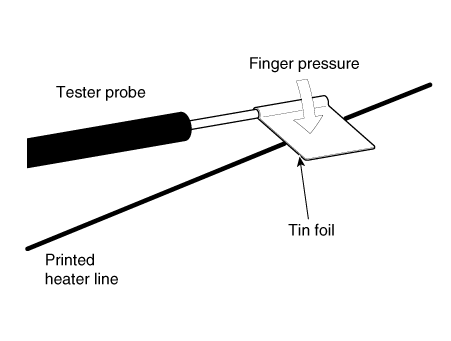Kia Optima: Rear Glass Defogger / Rear Glass Defogger Printed Heater
Repair procedures
| Inspection |
|

| 1. |
Turn on the defogger switch and use a voltmeter to measure the voltage of each heater line in the central part of the glass. If the voltmeter indicates 6V for a conductive line, the line of the rear window is considered to be in good condition.
|
| 2. |
If a conductive line is burned out within the area between the central part and (+) terminal, the voltmeter will indicate12V.
|
| 3. |
If a conductive line is burned out within the area between the central part and (-) terminal, the voltmeter will indicate 0V.
|
| 4. |
To check for open circuits, Slowly move the test lead toward the section where open circuits seem to exist. Try to find a point where the voltage turns to 0V. The point where the voltage has changed is the open-circuit point.
|
| 5. |
Use an ohmmeter to measure the resistance of each heater line between a terminal and the center of a grid line, and between the same terminal and the center of one adjacent heater line. The section with a broken heater line will have a resistance twice that in other sections. In the affected section, move the test lead to a position where the resistance sharply changes.
|
Repair of Broken Heater Line
Prepare the following items :
| 1. |
Conductive paint. |
| 2. |
Paint thinner. |
| 3. |
Masking tape. |
| 4. |
Silicone remover. |
| 5. |
Using a thin brush : Wipe the glass adjacent to the broken heater line, clean with silicone remover and attach the masking tape as shown. Shake the conductive paint container well, and apply three coats with a brush at intervals of about 15 minutes apart. Remove the tape and allow sufficient time for drying before applying power. For a better finish, scrape away excess paint with a knife after the paint has completely dried. (Allow 24 hours).
|
 Rear Glass Defogger
Rear Glass Defogger
Components and components location
Component Location
1. Rear glass defogger
switch
2. Engine room junction block
3. Rear glass defogger
...
 Rear Glass Defogger Switch
Rear Glass Defogger Switch
Repair procedures
Inspection
1.
In the body electrical system, failure can be quickly diagnosed by using
the vehicle diagnostic system (KDS).
The diagnostic system ( ...
Other information:
Kia Optima DL3 2019-2025 Owner's Manual: Good driving practices
Never move the gear shift lever from P (Park) to any other position with the accelerator pedal depressed. Never move the gear shift lever into P (Park) when the vehicle is in motion. Slow down before shifting to a lower gear. Otherwise, the lower gear may not be engaged. Always use th ...
Kia Optima DL3 2019-2025 Owner's Manual: Air intake control
This is used to select the outside (fresh) air position or recirculated air position. To change the air intake control position, push the control button. Outside (fresh) air position With the outside (fresh) air position selected, air enters the vehicle from outside and is heated or cooled ...







